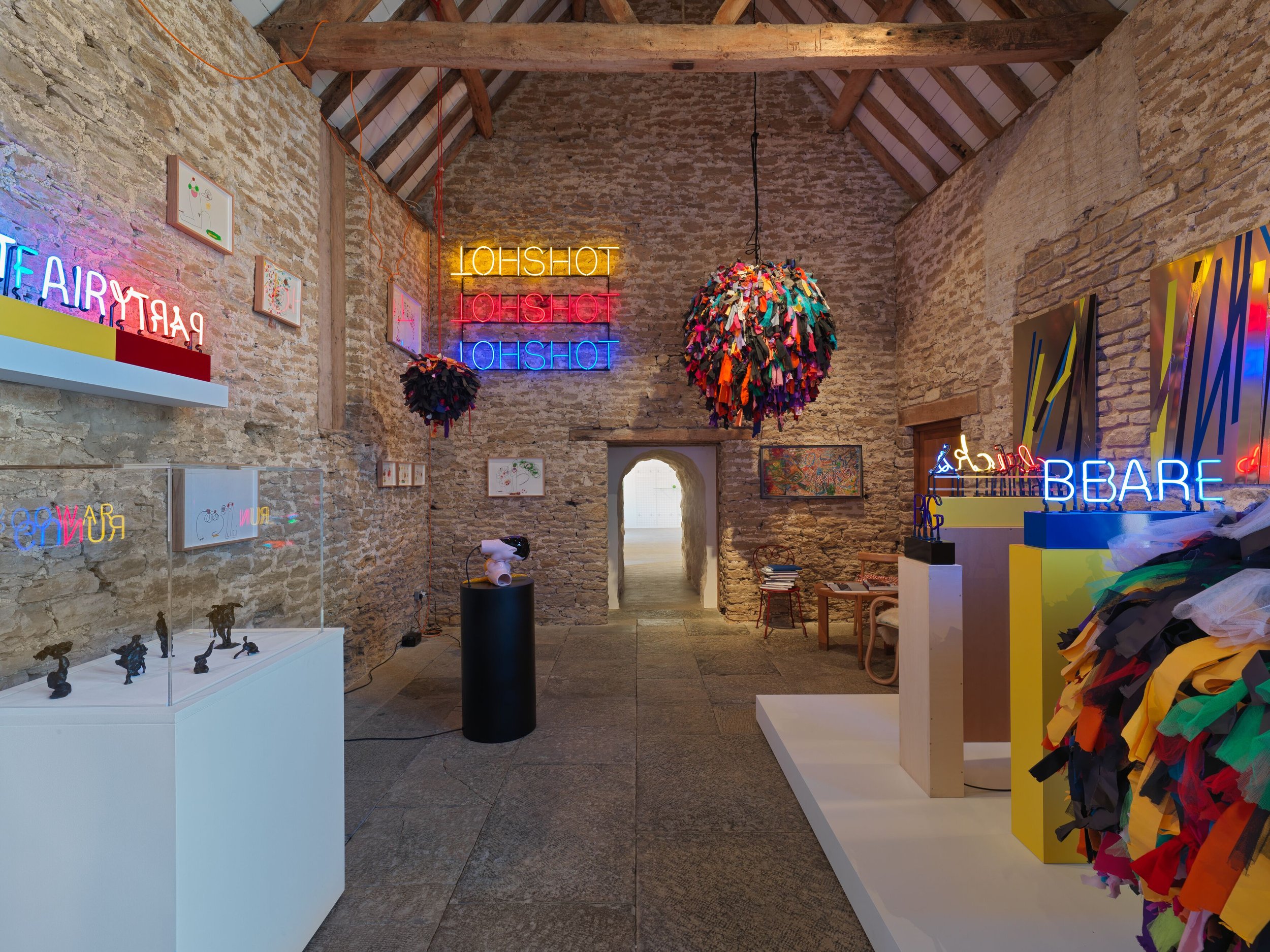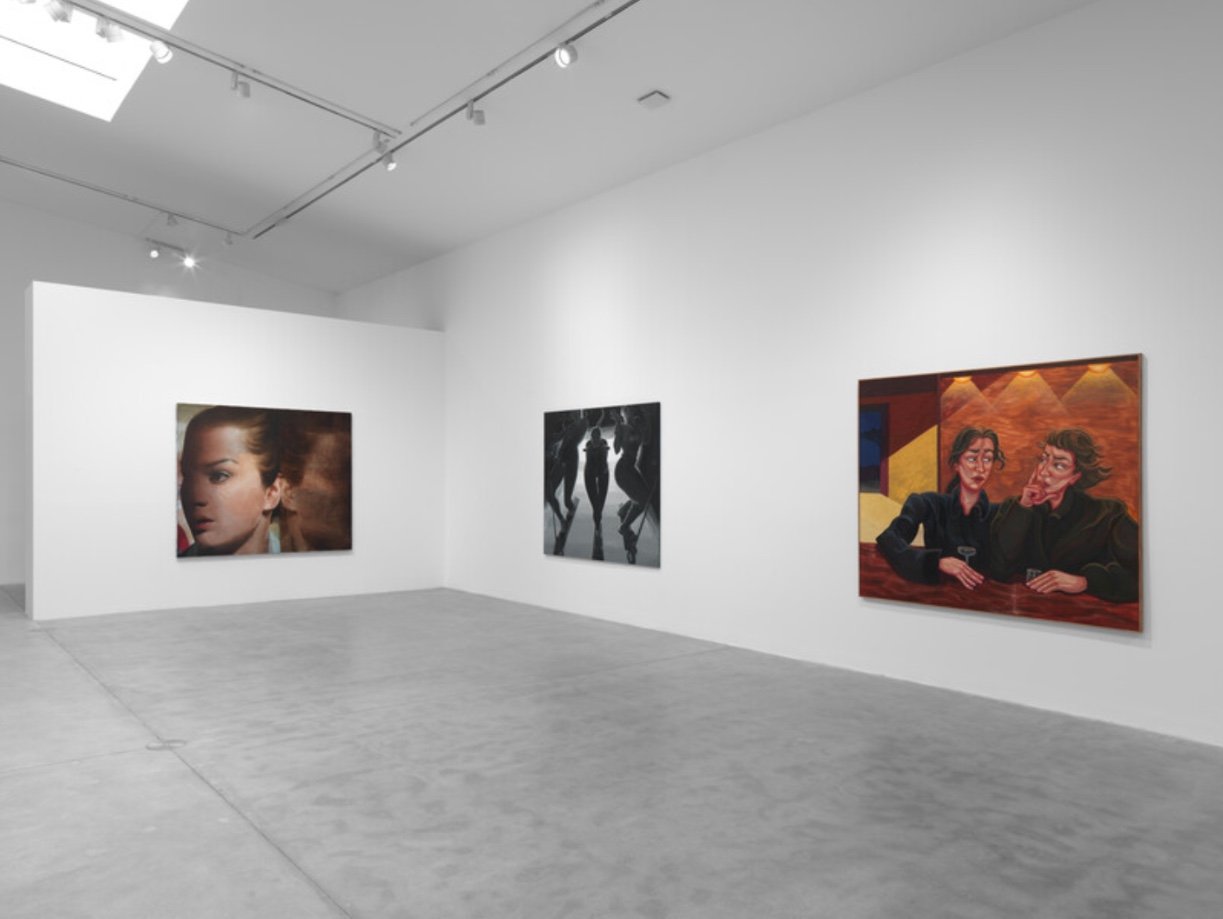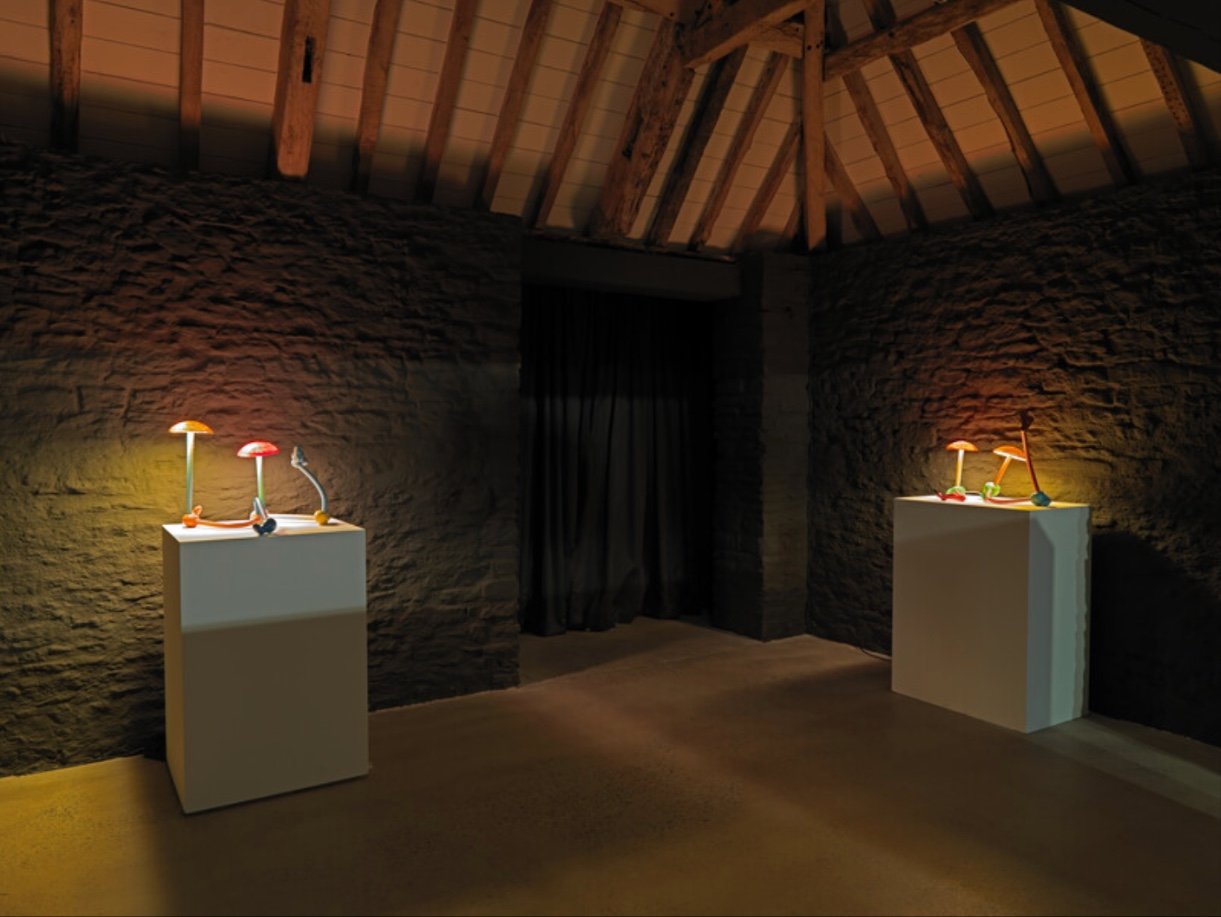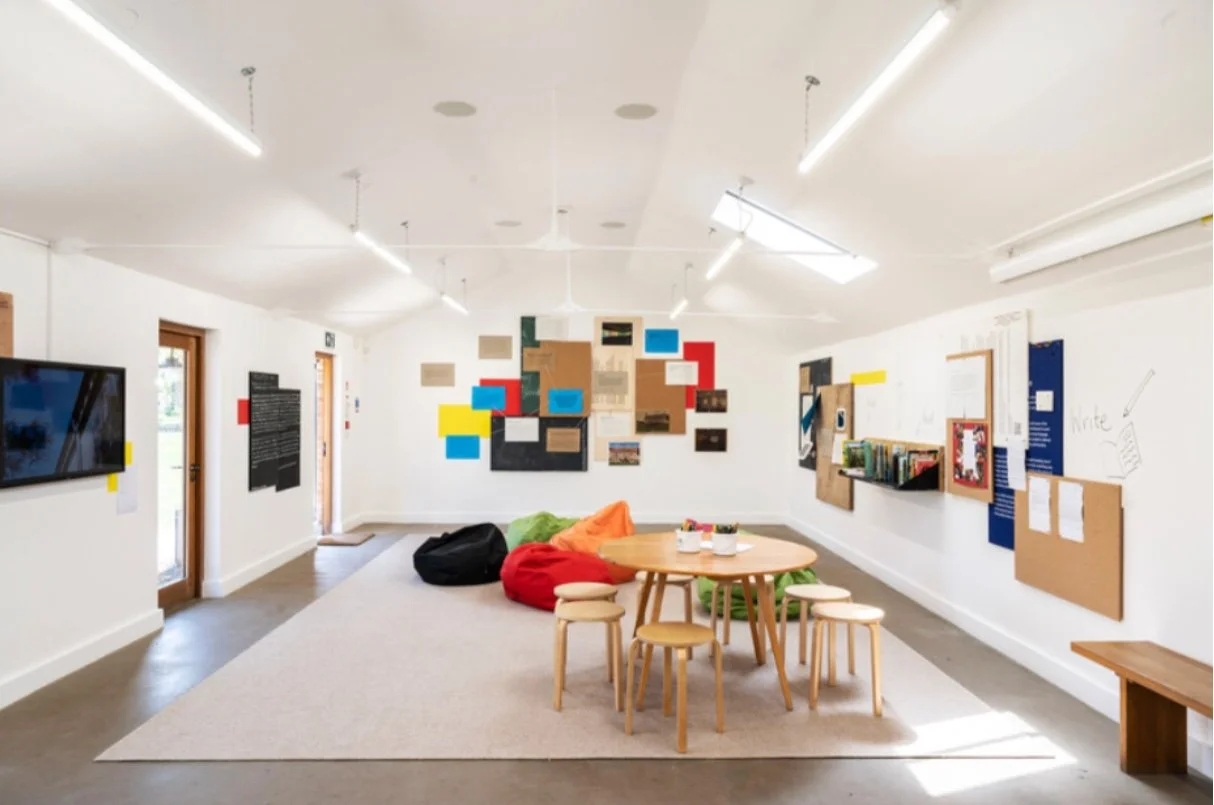GRUPPENAUSSTELLUNG | Hauser & Wirth Somerset
Gruppenausstellung
HAUSER & WIRTH somerset
3 JUN 2023 – 1 Jan 2024Overview
‘GRUPPENAUSSTELLUNG’ was a celebration of Hauser & Wirth’s Swiss heritage through a playful presentation of over 20 artists, including Phyllida Barlow, Martin Creed, Nicole Eisenman, Isa Genzken, Rodney Graham, Richard Hamilton, Mary Heilmann, Camille Henrot, Jenny Holzer, Richard Jackson, Rashid Johnson, Allison Katz, Paul McCarthy, Jason Rhoades, Pipilotti Rist, Dieter Roth, Björn Roth, Mika Rottenberg, Anri Sala, Cindy Sherman, Roman Signer, Lorna Simpson, Alina Szapocznikow, Franz West and David Zink Yi. The multidisciplinary exhibition was inspired by the notion of a traditional Kunsthalle, conceived as a place to showcase groundbreaking art and explore contemporary issues with a broad audience. The entire site takeover provided a platform for discovery and interaction, extending to all five galleries, outdoor sculpture and a collaborative events programme with the Roth Bar & Grill. The exhibition evolved in two parts over the course of seven months, featuring immersive installations, solo presentations and iconic video works. Alongside the exhibition, the Education Lab took its starting point from Mika Rottenberg and Pipilotti Rist’s commitment to environmentally sustainable creative practices.
‘GRUPPENAUSSTELLUNG’ took a major step forward with longer programming which had a range of positive consequences, reducing shipping, packaging and material use as well as the time our team dedicate to installations.
In our Bourgeois Gallery, Paul McCarthy’s ‘White Snow Dwarves’ (2010-2012) was on loan between June and August, and from September until January a collection of Franz West’s works was presented. The Cinema in the Rhoades Gallery screened a changing weekly schedule of video and films works, as well as evening film viewings.
Sustainable Exhibition Design Research
During the planning phase of this exhibition, our team was intentional in considering the full life cycle of materials, resources, transport, and presentation methods. Sustainability is a foundational mindset for our team at the Somerset gallery, prompting us to continually question our practices and explore alternatives for our presentations. While these discussions are ongoing and do not always immediately translate into practice, they represent iterative steps toward evolving the gallery’s operations. Given the size, scale, and scope of this exhibition, the team actively sought ways to incorporate sustainable practices into its presentation. Some of the research they explored during the planning phase included:
Paint
We are expanding our understanding of paint, its environmental impact, particularly with acrylic paint, and exploring potential alternatives. We identified Graphene lime paint as a promising substitute. Additionally, thanks to our friends at Hospital Rooms, we have learned about Coat paint. Moving forward, we aim to select paints that meet the following criteria:
• Trace VOCs only (under 0.1%)
• Chemical and preservative free
• No plastics, petrochemicals, preservatives
• No micro-beads
• Fully breathable and hardwearing
Sea Freight
Understanding that transporting artwork by sea can reduce carbon emissions by up to 90% compared to air freight, our team actively sought out works that could be shipped this way, especially from Hong Kong. During the planning phases, we presented the potential carbon savings of various artworks’ transit options. Although we couldn’t arrange sea transport in time, most of the show was transported via consolidated road freight from Switzerland, with only 10 works sent by air.
WHAT WE PUT INTO ACTION
Our team is steadily integrating environmental consciousness into our ways of working. Small shifts in behaviour can have a multiplier effect on the wider gallery team. This report highlights the collective decisions made by our team that positively impacted the exhibition’s overall environmental footprint.
Neon
The exhibition featured several neon artworks, prompting us to examine the pros and cons of traditional neon versus LED faux neon. From our neon fabricators in the US, we learned the following:
Pros of traditional glass neon:
• Production cost of custom neon can be less than LED.
• Neon can offer over 90 static colors, but LED can only offer 12 + / -.
• The design capability of neon is far greater than LED, especially in matching specific fonts and for custom graphics.
• Neon glass is recyclable, whereas LED, made of plastic, is not and ends up in landfills.
• Power requirements / electrical draw of neon is the same as LED if using electronic transformers.
• If neon is damaged or broken, it can be repaired. However, if even a small portion of an LED sign goes out, the entire section, and sometimes the entire sign, cannot be repaired and must be replaced completely.
• Neon can last up to 60-70 years
• Life of power supplies / transformers are identical for neon and LED, typically 5-10 years. These are 100% replaceable.
Pros of LED faux neon:
• Installation cost of LED can be less than custom neon
• LED can offer an infinity of colors if under RGB system, whilst neon cannot offer RGB.
• Power requirements / electrical draw of LED is less than neon if using magnetic transformers.
• Life of power supplies / transformers are identical for neon and LED, typically 5-10 years. These are 100% replaceable.
We discovered that typical neon lights consume 400 watts, compared to 150 watts for LED lights and 610 watts for fluorescent lights. Since our gallery operates on renewable energy, our team researched the energy efficiency of neon and decided to continue exhibiting the existing neon artworks based on this information.
DESIGNING FOR DISASSEMBLY - HOW OUR TEAMS REFUSE AND REUSE MATERIALS
We recognize that galleries are among the few public spaces that are consistently reimagined to bring artists’; ideas and curators’; visions to life. However, this also makes them significant consumers of building materials, often generating a continuous stream of landfill waste. Therefore, designing for disassembly is a crucial step toward an environmentally responsible art world.
Our team, particularly our Senior Art Handler, Sam Taylor, ensures that materials are salvaged and repurposed. Here are examples in this exhibition of refusing, reusing, and repurposing:
• We created gallery seating from free-standing walls from a previous exhibition
• For sound absorption we used sound panels from a previous installation which had been in storage for 10 years in Switzerland. These were transported on a consolidated truck from Switzerland.
• The existing wall in the Rhoades gallery has been kept in place for 18 months and numerous exhibitions prior to Gruppenausstellung, including Louise Bourgeois, Rodney Graham and the most recent ‘Present Tense’ show used that wall.
• We used decommissioned floorboards from our outdoor pavilion to clad the main plinth used for the Franz West installation.
• An undersurface steel framework that has been used for numerous outdoor sculptures was reused for the Camille Henrot, ‘Family of Men’ sculpture.
• In our Cinema, we opted not to use carpet, which can be challenging to repurpose and reuse. Instead, we utilized sheepskin rugs and beanbags borrowed from our Learning team. Additionally, in this space, we avoided painting the walls black to minimize paint consumption.
• Only one multi-crate was fabricated for the exhibition as existing packing was reused for the transits. The benefit of the multi-crate is that it requires less materials in comparison to individual crates.
• In the case of Mika Rottenberg’s ‘Cosmic Generator’ (2017), following the artist’s instructions, the tunnel was made using 70% reclaimed wood and Styrofoam.
Local residency – a combination of transport and locally sourced materials
One way to limit the transport emissions of artworks is to create and exhibit them locally. This concept is frequently discussed as a means for the art world to reduce its dependency on transportation and packaging. For instance, Mika Rottenberg did a short residency during the exhibition run and developed works onsite. Although some small elements were sent to the gallery by FedEx, she completed the fabrication on site. For this series, the artist designed the components of the Lamp sculptures to be shipped with minimal packaging.
HOW WE CAN DO BETTER
We are learning as we progress on our journey toward reduction. Our gallery team in Somerset is committed to environmental sustainability, but we recognize that we still operate within a system with established behaviours and habits. We are gradually shifting to new ways of working. Some of the ideas we were unable to implement for this project include:
• During the exhibition, our Invigilators conducted a digital ‘Travel Survey’ with visitors to better understand their travel patterns. By analysing this information, we hoped to identify patterns and trends in visitors’ transportation choices to allow to develop effective strategies to reduce our carbon footprint. However, the number of surveys we were ultimately able to collect was too low to advance this quantitative study.
• Wheat paste would have been a good alternative to solvent based paste for the outdoor posters
• Our team have identified several infrastructure upgrades including a green travel plan, upgraded bike stands, better signage of our waste, rainwater harvesting and air source heat pumps.
Our Education Lab, ‘Turning the Inside Outside: Sustainable Actions in the Art World’, was presented alongside the exhibition.
Inspired by Mika Rottenberg and Pipilotti Rist, the Education Lab was a platform for collaboration across Hauser & Wirth’s Green Teams globally. Through the Education Lab, our Somerset teams were given a physical forum to share knowledge and display new ideas in relation to the creative use and reuse of materials within our gallery ecosystem. Visitors were invited to take part in the activation of the space itself, to engage with themes of environmental sustainability, and be inspired to collaborate and create impact in this area.
In partnership with Bruton Town Council, we encouraged young people to reflect on an environmental issue affecting their local community and write a letter outlining the change they would like to see. Members of the town council’s ‘Climate and Ecological Emergency Working Group’ will read the letters and recommend actions required to the wider council, addressing the concerns raised and arriving at potential solutions.
Hauser & Wirth’s Climate Policy
In line with the Paris Climate Agreement of the United Nations, we are reducing our carbon emissions by at least 50 percent by 2030. Since making our commitment, we have cut down our emissions by 20 percent and continue to drive actions to accelerate meeting our target. Reductions are happening by switching to renewable energy, transitioning to LED lighting, purchasing electric vehicles and tracking carbon emissions and waste associated with our air freight.
Commitments
• Reduce our greenhouse gas emissions by a minimum of 50 percent by 2030 in line with the Science Based Targets initiative (SBTi). This includes reducing our freight, business travel and exhibition construction emissions.
• Support Strategic Climate Funds, including projects that preserve existing forests and positively impact communities backed up by climate justice initiatives.
• Actively promote and provide a platform for industry collaboration.
Energy actions in our Somerset gallery
Since 2021 our galleries have been using renewable energy. We have switched to LED lighting across our galleries, offices and storage spaces and we purchased an electric van for deliveries and installed a charging point.
Carbon Emissions
The exhibition’s carbon emissions were assessed according to Scope 1, 2 and 3 by the Carbon Accounting Company (CAC). The methodology for the exhibition emissions quantification follows the principles and methods of The GHG Protocol Corporate Accounting and Reporting Standard (https://ghgprotocol.org/corporate-standard). The lifecycle emissions quantification of construction materials follows the principles of the ISO 14040:2006 Standard (https://www.iso.org/standard/37456.html).
All data was collected and provided by Hauser & Wirth colleagues either directly in the data collection workbook provided by CAC, or in separately consolidated communications. While it is assumed that the data entered by Hauser & Wirth was accurate and complete, minor leakages in the Scope 3 carbon category are anticipated.
Areas Calculated
Further narrative about the carbon emissions of the exhibition
SCOPE 1
Stationary Combustion: 43,163 CO2e (location-based), 43,163 CO2e (market-based)
SCOPE 2
Grid Electricity: 34,925 CO2e (location-based), 61,585 CO2e (market-based)
SCOPE 3
Freight: 14,486 CO2e
There was a mix of air and road freight. Air freight weighed 781 kg (including packaging) and road freight was 81,134 kg, distances of 24,465 km and 7,144 km were travelled respectively. Air freight emissions were calculated using the volumetric weight of the shipment from Hong Kong. Calculating the carbon footprint of road transport has accuracy limitations because vehicle type is not accounted for. The calculation includes both inbound and outbound shipments.
Employee and artist travel: 3,764 CO2e
The travel that has been included in this report is by air, by car and by rail, with the distance travelled being 2,559 km, 16,985 km and 1,028 km respectively, amounting to 20,572 km in total.
Employee and artist accommodation: 395 CO2e
Exhibition construction: 2,570 CO2e
Materials used in the exhibition included: 92 litres of decorative paint; 276 kg of plaster; 784 kg of plywood; 281 kg of timber; 389 kg of MDF; 115 kg of stainless or galvanized steel and 24 kg glass.
Total Calculated Emissions: 99,857 CO2e (location based), 126,517 CO2e (market based)
Waste Report:
Using a material afterlife checklist, we categorized the destination of material used in the exhibition. Waste disposal generated 554 CO2e
Collective Action:
Completing and sharing a Climate Impact Report (CIR) with Artists Commit is a collective action!
As a next step, we encourage you to invite your artists, vendors, other galleries, museums, or institutions into the conversation. Perhaps to do a report with you, or to ask them if they are interested in supporting you as you complete yours.
Have a transparent conversation within the project team about other ways that the project can support collective action within the art sector:
● Share a Climate Impact Report at artistscommit.com.
● Share what was learned in the CIR to audiences.
● Ask project partners and collaborators about their climate policies, commitments, or priorities.
● Learn from what other projects have done, connect with other institutions or artists to ask for advice, acknowledge them in your report.
● Reach out to other organizations or local networks doing this kind of work. Some examples from the Visual Arts PACT:
○ Art to Acres
○ Art + Climate Action (California)
○ Art/Switch
○ Galleries Commit
○ Gallery Climate Coalition
○ Ki Culture
● Propose others do a CIR at the same time.
● Offer to be available to advise or support other artists or presenting partners who want to do a climate impact report for the first time.
● Make sure all artists you work with know that the Climate Impact Reports is an available tool.
● Use the report to refine future practices.
Credits
Carbon Emissions Metrics Prepared by: Stewart Gosbee, Health & Safety and Facility Manager; James Halliwell, Registrar; and Sam Taylor, Senior Art Handler.
CIR Prepared by: Ian Lipton, Carbon Accounting Company; Cliodhna Murphy, Global Head of Environmental Sustainability, Hauser & Wirth; and Nataliia Zvirkova, Environmental Sustainability Coordinator, Hauser & Wirth.
CIR Reviewed by: Dea Vanagan, Director, Hauser & Wirth Somerset; and Haley Mellin, Art to Acres
This exhibition’s Climate Impact Report (CIR) is published on the artist-led sustainability platform Artists Commit. Launched in November 2021, the CIR concept was created by Artists Commit. Written in June 2024, this is the fourth in a series of CIR’s published by Hauser & Wirth.
Exhibition link: https://www.hauserwirth.com/hauser-wirth-exhibitions/54966-gruppenausstellung/
Images: https://www.hauserwirth.com/hauser-wirth-exhibitions/54966-gruppenausstellung/
Thanks to Artists Commit team members Deville Cohen and Jessica Gath.
















